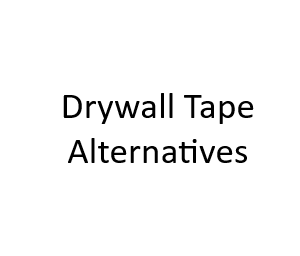Drywall tape is a crucial component in the process of creating smooth and seamless walls in homes and buildings. It’s traditionally used to reinforce joints and seams between drywall sheets, ensuring a durable and aesthetically pleasing finish. However, as with many construction materials, there are alternatives to traditional drywall tape that can be just as effective. In this blog post, we’ll dive into the world of drywall tape alternatives, exploring their advantages, disadvantages, and when they might be the right choice for your project.
The Role of Drywall Tape
Before delving into alternatives, let’s briefly review the role of traditional drywall tape. Drywall tape, typically made of paper or fiberglass, is applied to the joints and seams of drywall sheets. Its primary functions are:
- Reinforcement: Drywall tape reinforces the joints, preventing cracks and separations over time. It adds structural integrity to the wall.
- Smooth Finish: When combined with joint compound or mud, drywall tape creates a smooth surface over the joints, ensuring a seamless appearance.
- Crack Prevention: It helps minimize the risk of cracks developing along the seams, especially in areas prone to temperature fluctuations.
Now, let’s explore some drywall tape alternatives:
Mesh Tape
Mesh tape is one of the most popular alternatives to traditional paper drywall tape. It’s made of fiberglass and has a self-adhesive backing. Mesh tape offers several advantages:
- Strength: Mesh tape is known for its strength and durability, making it an excellent choice for high-traffic areas or where additional reinforcement is needed.
- Easy Application: The self-adhesive backing simplifies application, reducing the chances of wrinkles and bubbles.
- Crack Resistance: Its mesh structure helps distribute stress more evenly, making it less prone to cracking compared to paper tape.
Paper Tape
While this may seem counterintuitive as an “alternative,” paper tape still deserves mention. It’s been a staple in drywall finishing for decades and has its own set of benefits:
- Cost-Effective: Paper tape is often more affordable than some of the alternative options, making it a budget-friendly choice for DIYers.
- Smooth Finish: When applied correctly with joint compound, paper tape can result in a smooth, seamless finish.
- Mold Resistance: Some paper tapes are treated to resist mold and mildew growth, making them suitable for humid environments.
Fiber Tape
Fiber tape is another option worth considering. It’s made of a combination of fiberglass and paper and offers a unique set of advantages:
- Flexibility: Fiber tape is highly flexible, making it easy to work with around corners and curves.
- Moisture Resistance: Due to its fiberglass content, it’s more resistant to moisture compared to traditional paper tape.
- Strength: Fiber tape provides good joint reinforcement, ensuring long-term stability.
No-Tape Systems
In recent years, innovative drywall systems have emerged that eliminate the need for traditional tape altogether. These systems often involve interlocking drywall panels or adhesive-backed panels that don’t require tape for joint reinforcement. They can be a time-saving and efficient option for certain projects.
Application Tips for Drywall Tape Alternatives
Now that we’ve explored various drywall tape alternatives, let’s delve into some essential application tips to ensure a successful finish:
- Prepare the Surface: Before applying any tape alternative, it’s crucial to prepare the drywall surface properly. Ensure the seams are clean, free from dust and debris, and any loose drywall paper is removed.
- Use the Right Joint Compound: Choose the appropriate joint compound or mud for your chosen tape alternative. Some tape alternatives work better with specific types of joint compound. Follow the manufacturer’s recommendations.
- Apply Evenly: Whether you’re using mesh tape, paper tape, fiber tape, or a no-tape system, apply the joint compound evenly over the seam. Feather the edges to create a seamless transition between the taped area and the surrounding drywall.
- Smooth and Flatten: Use a drywall knife or trowel to smooth and flatten the joint compound. Apply enough pressure to embed the tape alternative but avoid pressing too hard, which can cause the tape to wrinkle or buckle.
- Multiple Layers: Depending on the type of tape alternative and the desired finish, you may need to apply multiple layers of joint compound. Allow each layer to dry thoroughly before applying the next.
- Sand Between Coats: Sand the joint compound lightly between coats to remove any imperfections and create a smooth surface. Be sure to wear a dust mask and eye protection when sanding.
- Check for Imperfections: After each coat of joint compound has dried, inspect the seams for any imperfections, such as air bubbles, cracks, or unevenness. Address these issues by applying additional joint compound and sanding as needed.
- Prime and Paint: Once you’re satisfied with the finish, prime the drywall surface and allow it to dry. Afterward, you can apply your chosen paint or wall covering.
- Follow Manufacturer Instructions: Always follow the manufacturer’s instructions for the specific tape alternative you’re using. Different products may have varying application and drying times.
- Practice and Patience: If you’re new to working with drywall tape alternatives, consider practicing on a small section of drywall before tackling a larger project. Patience is key to achieving a professional-looking finish.
In Conclusion
Drywall tape alternatives offer flexibility and options for achieving strong, seamless joints in your drywall projects. Whether you opt for mesh tape, paper tape, fiber tape, or a no-tape system, the key to success lies in proper surface preparation, careful application, and attention to detail during the finishing process.
Experiment with different tape alternatives to discover which one suits your specific project and skills best. With the right technique and a little practice, you can achieve beautifully finished walls that will stand the test of time. Happy drywalling!
